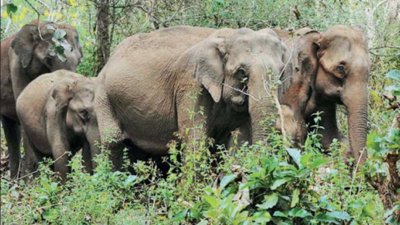411 wild jumbos died between 2018-2021 in Kerala
Category : Wildlife |
Location : Kerala | Posted on 2021-08-11 23:01:21

KOCHI: On the eve of World Elepehant Day, data from forest department show as many as 411 wild elephants and 55 captive ones died between 2018 and 2021 in Kerala. As per the 2017 elephant census data, there were 5,706 wild elephants in the state. Though the number of calves born during the period is to be estimated in the next census, with the death of 400-odd wild elephants, 7% of the population died during the period.
Rising man–animal conflicts caused by fragmentation of forest land has been identified as one of the major threats faced by the wild jumbos. While most died due to natural causes, retaliatory acts by locals, electrocution and train accidents killed several others.
The highest number of deaths were recorded in 2019 with 133 elephants dying in one year alone.
“Kerala or Western Ghats has good contiguous habitats that support wild elephants. At the same time, the landscape poses a threat to them not in terms of poaching but in terms of human–animal conflicts, largely due to land fragmentation, habitat loss and reduction in habitat quality. In view of climate change, there should be a combined effort to protect forest land. We cannot afford loss of forest land anymore. The compensatory afforestation has been taking place with little scientific study and planning,” said Sreedhar Vijayakrishnan, principal scientist in Centre for Wildlife Studies, Bengaluru.
While addressing man-animal conflicts, stress must be on modifying human behaviour instead of expecting the elephants to abandon their lifestyles, he said.
Forest department officials said though quite a few number of elephants have died in train accidents along the Walayar stretch, no such incidents have been reported since 2019, thanks to a coordinated effort by the railways and the forest department.
“We studied their behaviour and noted the time when they cross the railway tracks. They usually come out at night on their way to farm lands and return by early morning. We have intensified patrolling during that time. Besides, railways has improved its prewarning systems for loco pilots, flattened the embankments on either side of the track to make way for elephants in case trains are approaching, set up solar fences and taken other measures that seem to have improved things now,” says Krishnan, a forest watcher in Walayar range.
Former director of Kerala Forest research Institute (KFRI) Dr P S Easa said the change in land use has been the biggest contributor to the rise in incidents of man–animal conflict in the state.
“Places like Chinnakanal in Munnar witnessed largescale changes due to mushrooming of resorts. Forest areas have shrunk and land fragmentation is a big threat to ecology and wildlife,” he said.
With the number of captive elephants decreasing, there is increasing pressure on those that are deployed for parades during festivals. Around 3,330 festivals are conducted in the state every year. Thanks to Covid, captive elephants can take a breather now.
Source: https://timesofindia.indiatimes.com/city/kochi/411-wild-jumbos-died-between-2018-2021-in-kerala/articleshowprint/85260351.cms
